
Application of Derivatives. Jake Albert, Hardik Joshi, Hyun Kim. 1 st and 2 nd derivative tests. 1 st Derivative Test Used to find relative max/min at critical points Find derivative and determine critical values ‘Line Test’ for critical points. Line Test. Rolle’s Theorem.

eunice + Follow
Download PresentationAn Image/Link below is provided (as is) to download presentation Download Policy: Content on the Website is provided to you AS IS for your information and personal use and may not be sold / licensed / shared on other websites without getting consent from its author. Content is provided to you AS IS for your information and personal use only. Download presentation by click this link. While downloading, if for some reason you are not able to download a presentation, the publisher may have deleted the file from their server. During download, if you can't get a presentation, the file might be deleted by the publisher.
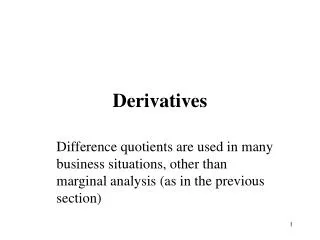
Derivatives. Difference quotients are used in many business situations, other than marginal analysis (as in the previous section). Derivatives. Difference quotients Called the derivative of f ( x ) Computing Called differentiation. Derivatives. Ex. Evaluate if .
677 views • 22 slides
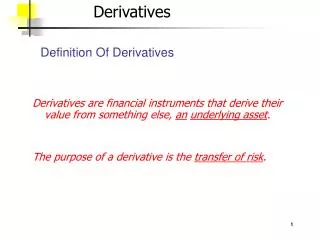
Derivatives are financial instruments that derive their value from something else, an underlying asset . The purpose of a derivative is the transfer of risk . Definition Of Derivatives. Derivatives . 1. Range of Derivatives. Exchange-Traded Futures. Interest-Only MBS Strip. Treasury
869 views • 33 slides
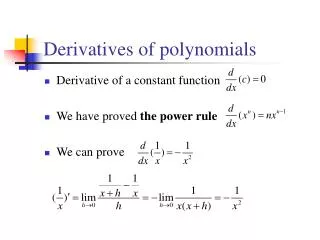
Derivatives of polynomials. Derivative of a constant function We have proved the power rule We can prove . Rules for derivative. The constant multiple rule: The sum/difference rule:. Exponential functions. Derivative of
760 views • 19 slides
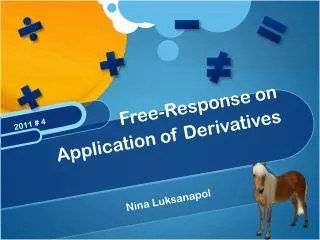
2011 # 4. Free-Response on Application of Derivatives. Nina Luksanapol . (a) Find g(-3). Find g’(x ) and evaluate g’(-3). g’(x )= 2 + f(x ) g’(-3)= 2 + f(-3) = 2+ 0 = 2.
287 views • 9 slides

Derivatives. Becoming an expert at derivatives in a few easy steps!. Gettin g Started (Click on a picture to get around). Definition. Examples. Understand the origin of Derivatives See the basic format for calculating the derivatives. Basic Trigonometric The natural log. Quiz.
409 views • 11 slides
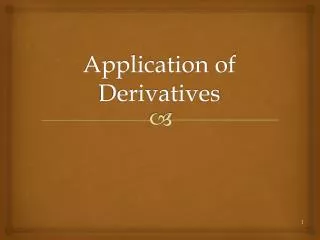
Application of Derivatives. Suppose a particle is moving in a straight line
693 views • 10 slides
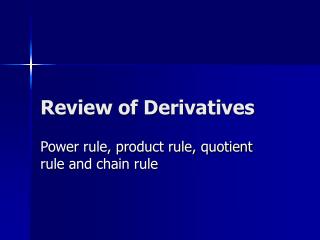
Review of Derivatives. Power rule, product rule, quotient rule and chain rule. The Power Rule. Remember, the power rule only works on functions of the form y = x n . The power rule says that y’ = nx n-1 Examples: y = x 2 , so y’ = 2x y =x 1/2 , so y’ = ½x -1/2 y = x -1 , so y’ = -x -2.
366 views • 7 slides
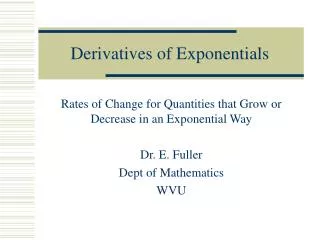
Derivatives of Exponentials. Rates of Change for Quantities that Grow or Decrease in an Exponential Way Dr. E. Fuller Dept of Mathematics WVU. Exponential Growth/Decrease.
196 views • 10 slides

Derivatives!. By: Emily Lael Halsmer. What is a Derivative Review. Specific things a derivative will tell you The slope of the tangent line to a curve The rate that something is changing
302 views • 11 slides

Derivatives. in physics. Why Do We Need Derivatives?. In physics things are constantly changing.
583 views • 20 slides
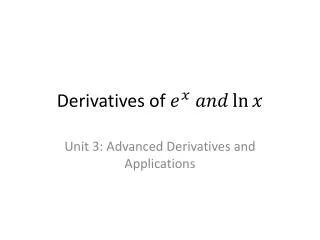
Derivatives of. Unit 3: Advanced Derivatives and Applications. Derivative of. In other words, keep the exponent the same and multiply by the derivative of the exponent. This is a process called differentiation by substitution . (though it may not be necessary for all problems)
389 views • 25 slides
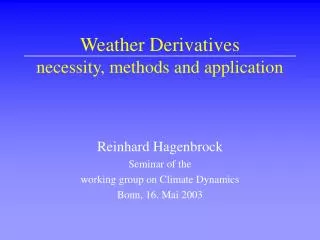
Weather Derivatives necessity, methods and application. Reinhard Hagenbrock Seminar of the working group on Climate Dynamics Bonn, 16. Mai 2003. Outline. “History” What is a ‘weather derivative’? Idealised example Market: players, -places and requirements Use of meteorology
654 views • 30 slides
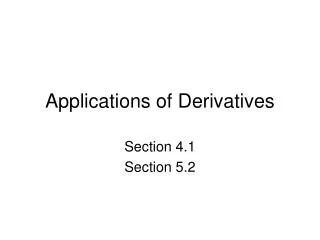
Applications of Derivatives. Section 4.1 Section 5.2. Applications of Derivatives. Derivatives allow you to sketch the shape of functions. Applications of Derivatives. Ex: Amount of cargo unloaded at a port related to the number of trucks. Applications of Derivatives.
1.01k views • 45 slides
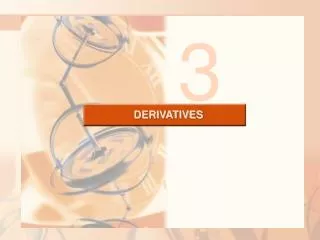
3. DERIVATIVES. DERIVATIVES. 3.8 Related Rates. In this section, we will learn: How to compute the rate of change of one quantity in terms of that of another quantity. RELATED RATES. Example 1.
444 views • 29 slides
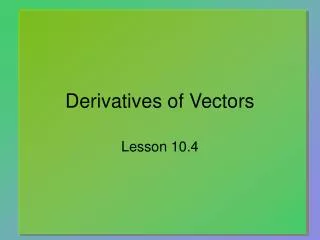
Derivatives of Vectors. Lesson 10.4. Component Vectors. Unit vectors often used to express vectors P = P x i + P y j i and j are vectors with length 1, parallel to x and y axes, respectively. P = P x i + P y j. j. i. Vector Functions and Parametric Equations.
268 views • 9 slides

Derivatives are financial instruments that derive their value from something else, an underlying asset . The purpose of a derivative is the transfer of risk. Definition Of Derivatives. Derivatives. 1. Range of Derivatives. Exchange-Traded Futures. Interest-Only MBS Strip. Treasury
705 views • 33 slides
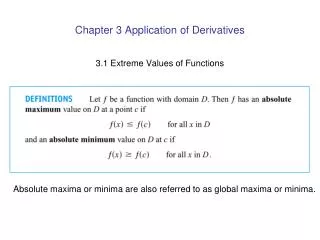
Chapter 3 Application of Derivatives. 3.1 Extreme Values of Functions. Absolute maxima or minima are also referred to as global maxima or minima. Examples. Extreme Value Theorem. The requirements in Theorems 1 that the interval be closed and finite, and
681 views • 46 slides
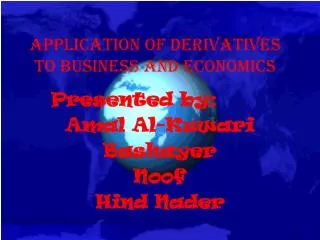
Application of derivatives to Business and economics. Presented by: Amal Al-Kuwari Bashayer Noof Hind Nader. Presentation content:. Introduction to Application of derivatives and it’s importance in the Business field The demand function The cost function The revenue function
2.22k views • 19 slides

Application of derivatives. Presented by; Jihad Khaled Becetti Kariman Mahmoud Malak Abbara Fatma Hussein Amna Al-Sayed Wadha Al mohannadi. The content. The definition of derivatives. The history of derivatives. The demand function. The cost function. The revenue function.
776 views • 29 slides

3. DERIVATIVES. Summary f ( x ) ≈ f ( a ) + f’ ( a )( x – a ) L ( x ) = f ( a ) + f’ ( a )( x – a ) ∆ y = f ( x + ∆ x ) – f ( x ) dx = ∆ x dy = f’ ( x ) dx ∆ y≈ dy. DERIVATIVES. We have seen that a curve lies very close to its tangent line near the point of tangency.
610 views • 37 slides

Derivatives of Vectors. Lesson 10.4. Component Vectors. Unit vectors often used to express vectors P = P x i + P y j i and j are vectors with length 1, parallel to x and y axes, respectively. P = P x i + P y j. j. i. Vector Functions and Parametric Equations.
423 views • 9 slides